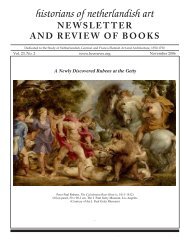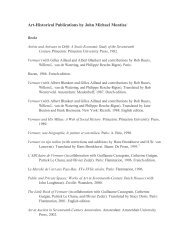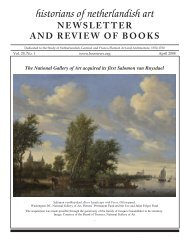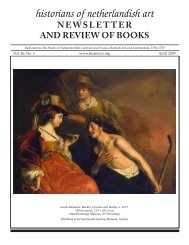newsletter - Historians of Netherlandish Art
newsletter - Historians of Netherlandish Art
newsletter - Historians of Netherlandish Art
Create successful ePaper yourself
Turn your PDF publications into a flip-book with our unique Google optimized e-Paper software.
Romeyn de Hooghe have received so many important commissions?<br />
Or rather, should the satirical texts mentioned above be<br />
used as documentary sources in the way it is done by some <strong>of</strong><br />
the authors? The artist’s deeds were especially criticized in Het<br />
Boulonnois hondtie <strong>of</strong> 1681, probably by Govert Bidloo. He is accused<br />
<strong>of</strong> being a kleptomaniac, a fi ddler, a forger and a fornicator.<br />
The author and the artist were well acquainted since at least<br />
as early as 1675 and they appear to have continued their collaboration<br />
for many years after the publication <strong>of</strong> the text. Was<br />
there really a fi ght between the two friends as serious as to justify<br />
such grave accusations? Or were the accusations in Bidloo’s<br />
text deliberately so outrageously exaggerated as to ridicule<br />
charges <strong>of</strong> much lighter <strong>of</strong>fences? Did the author simply try to<br />
help his friend? Also Romeyn’s output as printmaker is used<br />
to reach conclusions on the artist’s thoughts and preferences.<br />
From the large number <strong>of</strong> pro-House-<strong>of</strong>-Orange prints, one<br />
could possibly count him as member <strong>of</strong> the Orangist-league.<br />
But is it safe to assume he was sympathetic to the Jewish cause<br />
from just a few etchings with specifi c Jewish subjects? It is<br />
sometimes too easily forgotten that De Hooghe was an artist by<br />
pr<strong>of</strong>ession who had to earn his daily living by his work.<br />
The artist’s versatility as an etcher is stressed in essays on<br />
portrait prints, news prints, political prints, satirical prints and<br />
maps and other topographical prints. Of course, the distinction<br />
between these genres is arbitrary and, perhaps, anachronistic<br />
but the various authors remind us <strong>of</strong> this fact regularly. In fact,<br />
some <strong>of</strong> Romeyn de Hooghe’s most famous prints are clever<br />
combinations <strong>of</strong> the aforementioned genres. Lesser known aspects<br />
<strong>of</strong> Romeyn de Hooghe’s life and art are discussed in a further<br />
set <strong>of</strong> essays dedicated to his plans for a school <strong>of</strong> design,<br />
his paintings and his designs for decorative arts, respectively.<br />
Several legal documents regarding the founding <strong>of</strong> the school<br />
<strong>of</strong> design give detailed insights on De Hooghe’s didactic ideas.<br />
Not only printmaking was going to be taught. Drawing, painting,<br />
sculpture and pattern making (for decorative arts) were<br />
considered just as important. Moreover, an education in the arts<br />
was supposed to be provided for both the children <strong>of</strong> the city’s<br />
nobility as well as for orphans and other needy. The division <strong>of</strong><br />
work in De Hooghe’s studio becomes clear from the detailed<br />
documentation on the painted decorations in the town hall <strong>of</strong><br />
Enkhuizen, one <strong>of</strong> his large-scale painting projects. Romeyn<br />
proves to have been the designer and overseer rather than the<br />
painter. The actual execution was left largely to workshop assistants<br />
and/or hired hands.<br />
The Cornell publication provides many elaborate and well<br />
documented catalogue texts and the choice <strong>of</strong> etchings shows<br />
most aspects <strong>of</strong> De Hooghe’s career. In most cases, prints were<br />
chosen that are not discussed or only briefl y mentioned in the<br />
Amsterdam catalogue. The focus <strong>of</strong> the notes is on iconography.<br />
Notwithstanding the clear explanations <strong>of</strong> the prints’ subject<br />
matter, sometimes an elaboration on the circumstances <strong>of</strong> the<br />
publication <strong>of</strong> an individual work is badly missed as well as a<br />
discussion <strong>of</strong> De Hooghe’s imagery in the light <strong>of</strong> iconographic<br />
traditions. On the other hand, in a few cases, new information<br />
is brought forward. For instance, two new devotional manuals<br />
can now be added to the aforementioned short title list, an<br />
edition <strong>of</strong> Thomas a Kempis’ De Imitatione Christi printed in<br />
Cologne in 1669 and one printed in the same town in 1670 (cat.<br />
nos. 6 and 7).<br />
Both exhibition catalogues <strong>of</strong>fer a thorough inside into<br />
Romeyn de Hooghe’s life and art. None <strong>of</strong> them pretends to be<br />
a defi nitive study on the artist. The Amsterdam publication was<br />
written for the larger public but, at the same time, provides a<br />
status quaestiones in De Hooghe studies and a starting point for<br />
further research while the Cornell publication provides much<br />
additional information. The well-documented and eloquently<br />
composed texts bring so many new aspects to light that, inevitably,<br />
at the same time they also raise new questions.<br />
Jaco Rutgers<br />
Amsterdam<br />
New Titles<br />
Areford, David S., The Viewer and the Printed Image in Late<br />
Medieval Europe (Visual Culture in Early Modernity). Burlington,<br />
VT: Ashgate, 2010. ISBN 978-0-754-66762-9, $125. To be<br />
reviewed.<br />
Barockmalerei an Maas und Mosel. Louis Counet und die<br />
Lütticher Malerschule. Trier: Stadtmuseum Simeonstift, 2009.<br />
ISBN 978-3-930866-30-4. – Exhibition Stadtmuseum Simeonstift,<br />
Trier, 2009.<br />
Block Friedman, John, Brueghel’s Heavy Dancers:<br />
Transgressive Clothing, Class, and Culture in the Late Middle Ages.<br />
Syracuse: Syracuse University Press, 2010. ISBN 978-0-8156-<br />
3215-3.<br />
Bod, Rens, Jaap Maat, Thijs Weststeijn (eds.), The Making<br />
<strong>of</strong> the Humanities. Vol. 1: Early Modern Europe. Amsterdam:<br />
Amsterdam University Press, 2010. ISBN 978-90-8964-269-1,<br />
euro 44.50<br />
Bondgenoten <strong>of</strong> tegenpolen. Samenwerking tussen kunstverzamelaars<br />
en musea in Nederland. Ed. by Ineke van Hamersveld<br />
and Truus Gubbels. The Hague: Vereniging Rembrandt, 2010.<br />
ISBN 978-90-6650-099-0, euro 34.<br />
Bruijnen, Y., Jan Rombouts. The Discovery <strong>of</strong> an Early<br />
Sixteenth-Century Master (Ars Nova). Turnhout: Brepols, 2010.<br />
ISBN 978-2-503-52569-3, euro 120.<br />
Buchanan, Iain, Habsburg Tapestries (Studies in Western<br />
Tapestry, 4). Turnhout: Brepols, 2010. ISBN 978-2-503-51670-7,<br />
euro 100.<br />
Burmeister Kaaring, David, Det kunstfaerdige billede:<br />
Haarlem-Manieristerne 1580-1600. Copenhagen: Statens Museum<br />
for Kunst, 2009. ISBN 978-8-7920-2339-1. – Exhibition catalogue.<br />
Chapman, H. Perry, Joanna Woodall (eds.), Envisioning the<br />
<strong>Art</strong>ist in the Early Modern Netherlands (Netherlands Kunsthistorisch<br />
Jaarboek/ Netherlands Yearbook for History <strong>of</strong> <strong>Art</strong>, 59) Zwolle:<br />
Waanders, 2010. ISBN 978-90-400-7683-1.<br />
Cherry, Peter, John Loughman, Lesley Stevenson, In the<br />
Presence <strong>of</strong> Things: Four Centuries <strong>of</strong> European Still-Life Painting.<br />
I: 17th-18th Centuries. Lisbon: Fundacao Calouste Gulbenkian,<br />
2010. ISBN 978-97-2884-4870-6. – Exhibition Museu Calouste<br />
Gulbenkian, Lisbon, February 12 – May 2, 2010. Previously<br />
listed without catalogue information.<br />
Cranach und die Kunst der Renaissance unter den Hohenzollern.<br />
Kirche, H<strong>of</strong> und Stadtkultur. Berlin: Deutscher Kunstverlag,<br />
2009. ISBN: 978-3-422-06910-7. – Exhibition Schloss<br />
Charlottenburg and Evangelische Kirchengemeinde St. Petri-St.<br />
Marien, Berlin, October 31, 2009 – January 24, 2010. Reviewed<br />
in this issue.<br />
HNA Newsletter, Vol. 27, No. 2, November 2010<br />
33







